Adolescentes e jovens mulheres
gritando até perder a voz. Quando elas finalmente veem o ídolo, elas gritam
mais alto, choram, desmaiam. Algumas delas até perseguiam o ídolo, em busca de
um autógrafo, foto ou talvez, uma mecha de cabelo. Seriam elas fãs do século
XXI, loucas pelo cantor mais famoso do momento? Não. Fãs malucas não são
novidade. Será que Al Jolson teve de lidar com flappers malucas? Havia groupies
que seguiam Beethoven? Obviamente, eu não posso responder a estas perguntas por
falta de provas, mas posso mostrar um exemplo de super-estrelato de 70 anos
atrás. Nos anos 40, quase todas as garotas eram loucas por Sinatra.
Teenagers and
young women screaming until they become voiceless. When they finally see their
idol, they scream louder, cry, faint. Some of them even go after the idol, in
the pursuit of an autograph, photo or, maybe, a lock of hair. Are they 21st
century fans of the newest singer who is currently in vogue? No. Insane fans is
nothing new. Did Al Jolson have to deal with crazy flappers? Were there any
Beethoven groupies? Of course, I can't answer these questions because I don't
have any proof, but I can show an example of superstardom from 70 years ago. In
the 1940s, almost all girls were crazy for Sinatra.
Francis Albert Sinatra nasceu em
1915. O jovem Frank amava música e, de acordo com livros biográficos, começou a
cantar em reuniões familiares e no bar de seus pais em Hoboken – ele aprendeu
música de ouvido, ou seja, sem aprender a ler partituras. Quando ele tinha 20
anos, conheceu o sucesso pela primeira vez: como membro do grupo “The Hoboken
Four”, ele conseguiu seu primeiro contrato para uma turnê. E adivinhe qual dos
quatro meninos de Hoboken chamava a atenção de todas as garotas?
Francis
Albert Sinatra was born in 1915. Young Frank loved music and, according to
biographic books, started performing at family gatherings and at his parents'
tavern in Hoboken – he only learned music by ear, that is, he couldn't read
music sheets. When he was 20, he had his first break: as a member of the group
“The Hoboken Four”, he got his frst contract for a tour. And guess which of the
four boys from Hoboken attracted all the girls' attention?
Depois de cantar com a orquestra de
Tommy Dorsey, era a hora de Frank Sinatra começar a carreira solo e causar
furor no mundo da música. Em dezembro de 1942, Frank estava nervoso com esta
mudança na carreira, mas quando ele chegou ao teatro Paramount em Nova York,
foi outra coisa que o deixou nervoso: a animação das fãs. Havia milhares de
adolescentes histéricas, que conheciam suas canções do rádio e estavam agora
mais do que animadas para vê-lo ao vivo.
After singing
with the Tommy Dorsey orchestra, it was time for Frank Sinatra to go solo and
cause mayheim in the music world. In December 1942, Frank was nervous as he was
beginning his solo career, but when he arrived in the Paramount Theater in New
York, something else made him nervous: the excitement of his fans. There were
thousands of hysterical bobby-soxers, teenagers who had heard him on the radio
and now were more than excited to see him live.
E durante os três anos seguintes,
Sinatra continuou levando as adolescentes à loucura – mesmo sendo um homem
casado de quase trinta anos... ou talvez tenha sido essa a razão? O clímax de
sua popularidade e um pináculo na cultura pop americana é o chamdo “Columus
Day riot”: um concerto, novamente no teatro Paramount em Nova York, em 12 de
outubro de 1944, atraiu um recorde de fãs malucas. À meia-noite, a fila começou
a se formar, e em quatro horas já havia 500 adolescentes esperando na fila para
ver Frank. Algumas delas nem tinham ingressos, elas só queriam a oportunidade
de ver o ídolo de perto. Soa familiar, não?
And during
the following three or four years, Sinatra kept on driving teenagers crazy –
even though he was a married man in his late 20s... or maybe this was the
reason? The climax of his popularity and a pinnacle in American pop culture is
the Columbus Day riot: a concert again at the Paramount Theater in New York on
October 12th 1944 that attracted more crazy fans than ever. At midnight, the
line started forming, and in four hours there were already 500 teenagers
waiting to see Frank. Some of them didn't even have tickets, they only wanted
the opportunity to catch a glimpse of the idol. Sounds familiar, doesn't it?
Essas garotas eram loucas por estarem
apaixonadas por Frank Sinatra? Eu acho que não. Ele era um homem muito magro,
com olhos azuis, cabelos pretos e uma voz que não parecia combinar com seu
corpo. Ele tinha beleza e talento. Em um nível subconsciente, ele era um
símbolo dos tempos de guerra: ele foi considerado inapto a servir o exército e
ficou nos EUA cantando, e para muitas garotas ele representava o garoto
conhecido que estava lutando na Europa – e que poderia nunca mais voltar. O
próprio Sinatra disse que a solidão dos anos de guerra foi uma das coisas
responsáveis por seu imenso sucesso.
Were these
girls right to be crazily in love with Frank Sinatra? I think so. He was a very
skinny, blue-eyed, black-haired man with a powerful voice that didn't seem to
match his physique. He had looks and talent. In a subconscious level, he was a
symbol in war times: he was considered unfit to serve the army and stayed in
the US singing, and for many girls he represented the boy-next-door that was
fighting in Europe – and could never return. Sinatra himself said that the
loneliness of war years was one of the things responsible for his massive
success.
Em seus primeiros filmes, esta imagem
foi explorada. Em “Marujos do Amor” (1945), seu personagem, Clarence, é muito
tímido e pede para que o maigo Joe (Gene Kelly) o ensine a conquistar as
garotas. Ele é, no filme, o tipo mais fofo de tímido, e até canta a doce “I
Fall in Love Too Easily”. Um comportamento semelhante é encontrado em Chip, seu
personagem em “Um dia em Nova York” (1949). chip quer ver todos os pontos
turístico de NY que seu avô um dia viu – o problema é que a maioria destes
pontos não existe mais. Chip não corre atrás de uma garota como o Gabey de Gene
Kelly faz – é a esperta taxista Hildy (Betty Garrett) que tem de flertar
agressivamente com ele mais de uma vez.
In his first
films, this image was explored. In “Anchors Aweigh” (1945), his character,
Clarence, is too shy and asks his friend Joe (Gene Kelly) to teach him how to
get girls. He is, in this film, the cutest kind of shy, and even sings the
sweet song “I Fall in Love Too Easily”. Almost the same kind of behavior can be
found in Chip, his character in “On the Town” (1949). Chip wants to see all the
New York landmarks his grandfather has once seen – the problem is that almost
all of these landmarks don't exist anymore. Chip doesn't pursue a girl like
Gene Kelly's Gabey does – it's smart taxi driver Hildy (Betty Garrett) that
must flirt with him aggressively again and again.
É interessante notar como nós ainda
usamos alguns termos e ideias da Sinatramania em conceitos de fandoms de
internet. Frank era comumente chamado de “Swoonatra”. As garotas da fandom
chamavam a si mesmas de “Sinatratics” - da mesma maneira que a fandom da
Beyonce é a “beyhive” e nós fãs de Benedict Cumberbatch nos chamamos de
“Cumberbitches”. Eu só imagino que hashtags as fãs de Sinatra usariam no
Twitter e no Tumblr...
It's very
interesting to notice how we still use some terms and ideas from the
Sinatramania in our concepts of internet fandom. Frank was commonly referred to
as “Swoonatra”. The girls in his fandom called themselves “Sinatratics” - in
the same way that the Beyonce fandom is the “Beyhive” and we Benedict
Cumberbatch's fans call ourselves “Cumberbitches”. I only wonder what hashtags
the Sinatratics would use on Twitter and Tumblr...
Elas também faziam “cosplay”: as fãs
usavam gravata-borboleta, assim como o ídolo, e geralmente prendiam uma foto de
Sinatra com um alfinete na roupa. E muitas pessoas encontraram um jeito de
explorar a Sinatramania para ganhar dinheiro: havia vários produtos com o rosto
de Sinatra estampado, ele foi capa de diversas revistas e, uma vez, algumas
fotos foram tiradas mostrando Frank Sinatra como membro de um coral no ensino
médio. O problema é que as fotos foram tiradas pelo fotógrafo Peter Martin para
trazer Sinatra ainda mais perto de suas fãs – na verdade, ele nunca foi parte de
um coral e já tinha 27 anos quando a foto foi tirada. Suas fãs,
obviamente, não se importaram.
They also
kind of cosplayed: the Sinatratics wore bow-ties, just like their idol, and
usually pinned Sinatra's pictures to their outfits. And many people found a way
of exploring the Sinatramania in order to make money: there were several
products with Sinatra's face on it, he was on the over of many magazines, and
once, some publicity photos were taken showing Frank Sinatra as a member of a
high school glee club. The problem was that the photos were staged by
photographer Peter Martin in order to make Sinatra even closer to his fans – in
reality, he was never a part of a glee club and was actually 27 when the pic
was taken. The
fans, of course, didn't care.
Frank Sinatra viu sua carreira
cinematográfica sofrer no final dos anos 40, mas retornou em 1953 com uma
performance ganhadora do Oscar em “A um passo da eternidade”. Sua carreira na
música foi um sucesso até sua morte, em 1998 – 20 anos atrás – e não podemos
negar que ele ainda é uma das maiores influências no mundo da música (de acordo
com o Spotify, Frank tem mais de 5 milhões de ouvintes mensais fiéis na
plataforma de streaming, incluindo eu). Para ele e para a cultura pop, a
Sinatramania foi só o começo.
Frank Sinatra
saw his film career suffer a little in the end of the 1940s, but he returned in
1953 with an Oscar-winning performance in “From Here to Eternity”. His singing
career was successful until his death, in 1998 – 20 years ago – and we can't deny
that he is still a major influence in the music world (according to Spotify,
Frank has more than 5 million faithful monthly listeners on the straming
platform, me included). For him and for pop culture, Sinatramania was just the
beginning.
This
is my contribution to the Reel Infatuation blogathon, hosted by Ruth
at Silver Screenings and Maedez at Font & Frock.

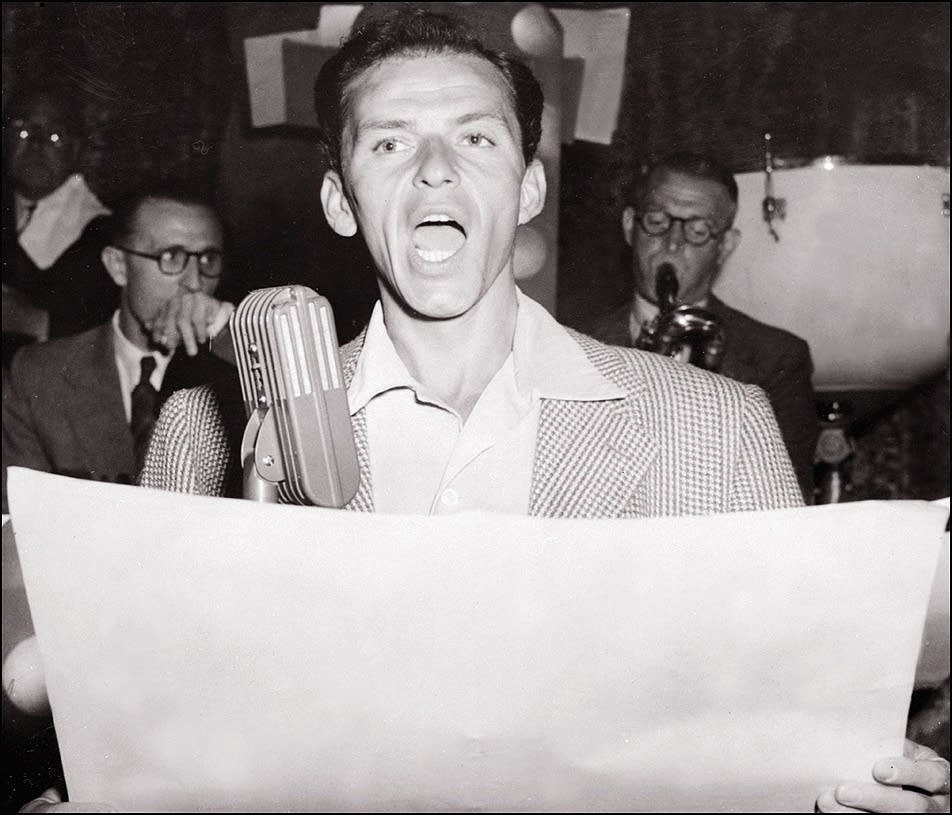



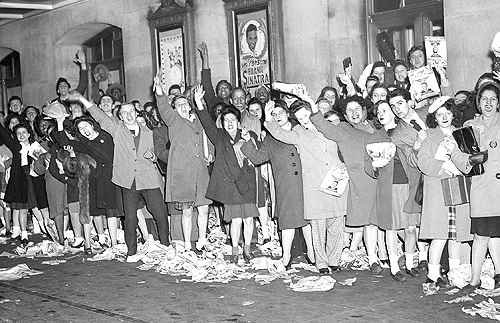
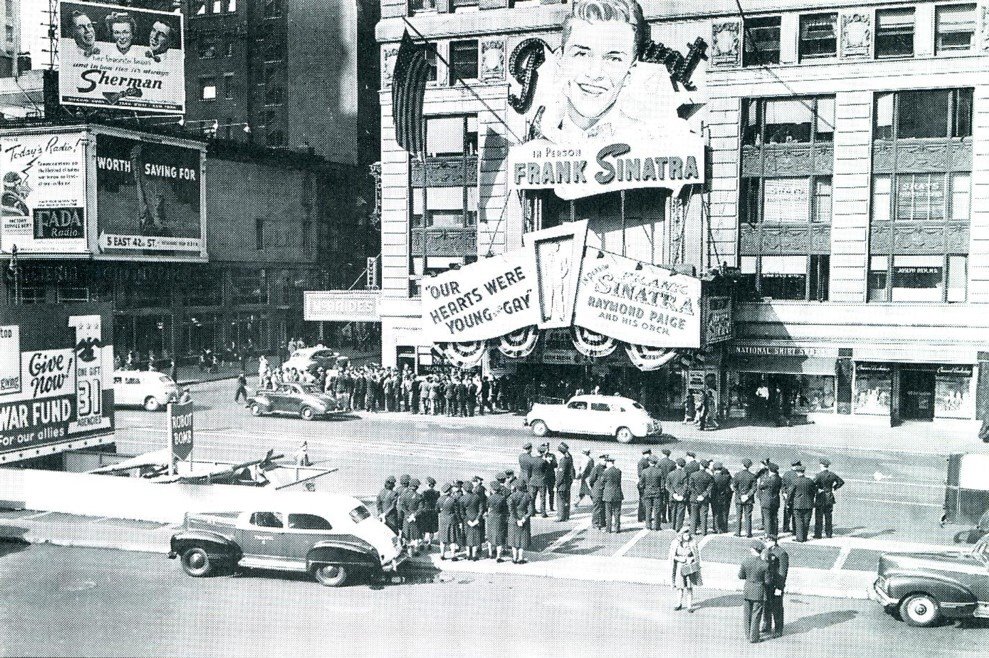


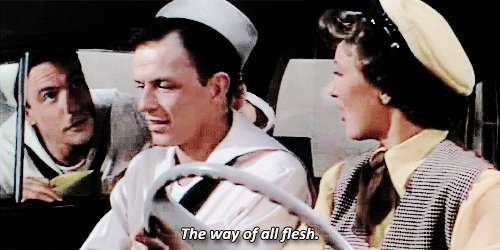
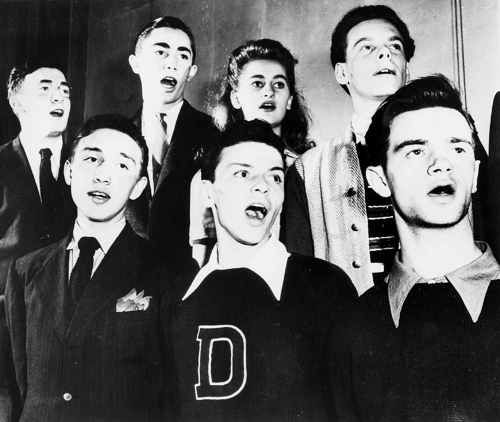
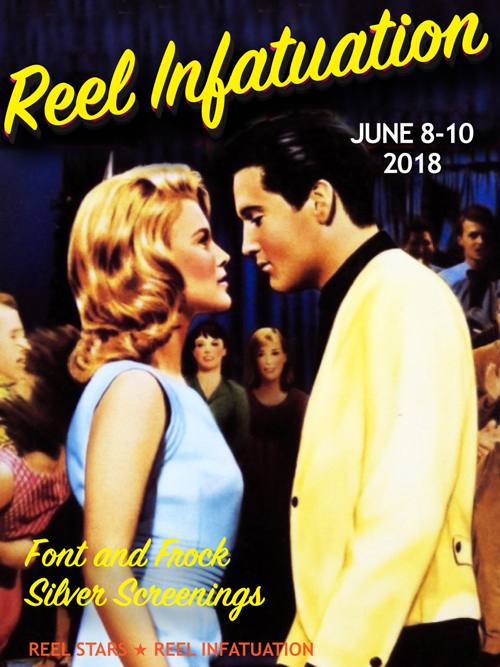
4 comments:
I knew Sinatra was big, but I didn't realize he was THAT big! Fans wore bow ties and pinned his photo to their clothes? That is true fandom.
With some celebrities, you can't help but think there was no way they would ever NOT be famous. Sinatra was one of those, in my opinion. Talented, charming, good looking and, as it turned out, a good actor.
Thanks for posting photos of the fans. The early part of his career is one I haven't really looked into, so it was fascinating to learn more about that. If I didn't know these young women were Sinatra fans, I would've thought they were fans of the Beatles!
Thanks for joining the blogathon, and thanks for reminding us how special Frank Sinatra truly was.
I confess I have always struggled with Sinatra - I certainly appreciate him, both as a musician and an actor - but I never found him to be sexy. However, I guess I'll just have to settle into the minority as millions of bobby-soxers couldn't be wrong! Great post and a reel infatuation phenomenon!
I've never personally experienced the over-the-top fan reaction to a performer, but I can't deny that along with the craziness that came with those bobbysoxers of the era, they certainly had the benefit of a singer who could really sing!
LOVE Sinatra! Undoubtedly one of the greatest singers of all time.
Great post, as always.
Carol, The Old Hollywood Garden
Post a Comment